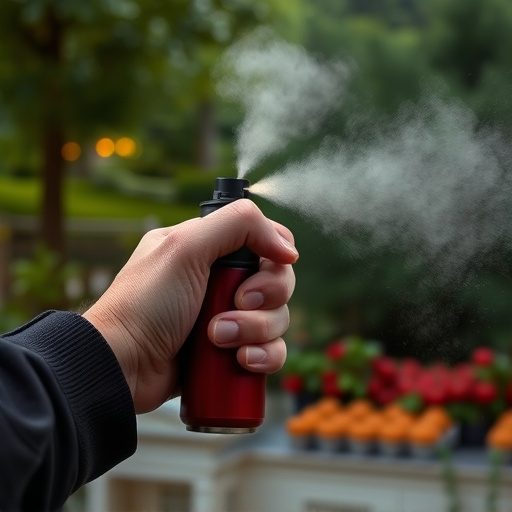The Pepper Spray Eye Washing Procedure is crucial for neutralizing capsaicin's effects after exposure. Flushing eyes with clean water for 15 minutes provides immediate relief and prevents long-term damage. Regular training ensures individuals can effectively use pepper spray as a self-defense tool, while understanding local laws regarding its legal utilization is essential.
Pepper spray, a powerful deterrent and self-defense mechanism, has become a common tool for personal safety. This article delves into the science behind pepper spray’s active ingredients and their effect on the human body and senses. We also explore crucial aspects like proper eye washing procedures after exposure and legal considerations for its use in self-defense. Understanding these key components ensures individuals can effectively utilize pepper spray as a legitimate defense mechanism while adhering to legal boundaries, especially with regard to the essential Pepper Spray Eye Washing Procedure.
- Understanding Pepper Spray's Active Ingredients
- How Pepper Spray Affects the Body and Senses
- Effective Eye Washing Procedure After Exposure
- Legal Considerations for Self-Defense Use of Pepper Spray
Understanding Pepper Spray's Active Ingredients
Pepper spray, a powerful deterrent and self-defense mechanism, contains active ingredients designed to disrupt an attacker’s senses and mobility. The primary component is capsaicin, derived from chili peppers, which irritates the eyes, nose, and respiratory system when in contact. This irritation leads to temporary blindness, tearing up, and difficulty breathing, allowing the user time to escape or defend themselves. Understanding the pepper spray eye washing procedure is crucial; it involves immediate flushing of the eyes with clean water for at least 15 minutes to alleviate discomfort and prevent potential long-term damage.
The effectiveness of pepper spray relies on its ability to create a sudden, overwhelming sensory experience, making it a game-changer in personal safety. Its active ingredients are carefully formulated to cause minimal harm to the user while ensuring the attacker experiences a strong disorienting effect. Regular training and awareness of the pepper spray eye washing procedure are essential for individuals looking to utilize this defense mechanism to its fullest potential.
How Pepper Spray Affects the Body and Senses
Pepper spray, a common self-defense mechanism, affects the body and senses by targeting the eyes, nose, and respiratory system. When activated, it releases a potent chemical compound known as capsaicin, which irritates these sensitive areas. This irritation leads to a range of physiological responses. In terms of eye washing procedure, immediate flushing with water is crucial to dilute and wash away the pepper spray residue. The stinging sensation, tearing up, and temporary blindness or reduced visibility are direct consequences of capsacin binding to nerve endings. Similarly, the respiratory system can be affected, causing coughing, difficulty breathing, and a burning sensation in the throat due to the chemical’s ability to irritate mucous membranes.
The impact on the senses is significant, as it can disorient and incapacitate an attacker temporarily. In light of these effects, understanding the pepper spray eye washing procedure becomes vital for effective self-defense. This knowledge allows individuals to mitigate the pain and potential long-term damage caused by such irritants, ensuring their safety and well-being in high-risk situations.
Effective Eye Washing Procedure After Exposure
After exposure to pepper spray, proper eye washing is crucial for immediate relief and to prevent further irritation or damage. The first step is to move the affected individual to a safe, well-ventilated area away from the source of the spray. Next, gently flush both eyes with clean, cool water for at least 15 minutes. Hold the eyelids open using a clean hand or cloth to ensure thorough irrigation. This process helps to dilute and wash away any remaining pepper spray particles.
For added protection, consider using eye washing stations or pre-filled eye rinse cups designed specifically for emergency situations. These can be easily accessed in public places, such as gyms, schools, or outdoor events, where pepper spray incidents are more likely. It’s also beneficial to educate individuals on how to perform this eye washing procedure, especially those who may be at higher risk of exposure, like law enforcement officers, security personnel, or people living in areas with high crime rates.
Legal Considerations for Self-Defense Use of Pepper Spray
The legal implications surrounding the self-defense use of pepper spray vary significantly across jurisdictions, emphasizing the importance of understanding local laws before carrying and employing this deterrent. In many regions, individuals have the right to protect themselves with reasonable force, which may include using pepper spray when faced with an imminent threat. However, there are strict guidelines on how and when it can be used legally. For instance, some areas mandate a clear and immediate threat of bodily harm or criminal attack before deploying pepper spray as a defense mechanism.
Moreover, the legal considerations extend to the potential for eye washing procedures following exposure to pepper spray. While pepper spray is designed to temporarily incapacitate an attacker by irritating the eyes, nose, and respiratory system, it can also cause discomfort and even vision impairment. In cases where pepper spray is legally used in self-defense, individuals should be aware of their responsibilities regarding any resulting harm. This includes ensuring prompt medical attention for victims, especially if eye washing procedures are necessary to alleviate pain or restore clear vision.
Pepper spray, as a self-defense mechanism, is a powerful tool that can neutralise an attacker. Understanding its ingredients and effects is crucial, especially for effective eye washing procedures after exposure. Knowing the legal considerations behind its use empowers individuals to defend themselves responsibly. By following proper eye washing protocols, individuals can minimise discomfort and ensure their safety in potential encounters, making pepper spray a valuable addition to personal defence strategies.
